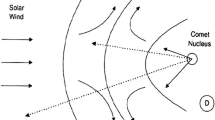Abstract
Obstacles in the solar wind are weak when their extension is small or comparable to the characteristic ion gyroradii. In this case interactions involve kinetic features, and hybrid models are an adequate description. A hybrid code operating on a curvilinear 3D grid and its application to solar wind interaction with weak obstacles is discussed. The cases of weak comets and the planet Mars are taken as examples. The cometary case is adapted to 67P/Churyumov–Gerasimenko (CG), which is the target of the Rosetta mission. The hybrid simulations follow the evolution of the plasma environment between heliocentric distances of 3.5 AU and 1.75 AU. Beyond 3.5 AU the activity of CG is extremely weak and the cometary ions mainly behave as test particles. For decreasing distances from the Sun the cometary ion production rate increases and the reaction of the cometary plasma to the solar wind becomes significant. Plasma structures such as a cometopause, bow shock and precursors of a magnetic cavity appear. The cometopause separates the cometary plasma and solar-wind plasma in a pronounced way. There is a typical asymmetry in the interaction region, including the tail. In certain respects the structures in the case of Mars are comparable to those of CG. The cometopause is replaced by the ion composition boundary, which separates Martian plasma and solar-wind plasma. The bow shock and the asymmetry in the interaction region are similar to the cometary case. However, the largely constant heliocentric distance of Mars gives rise to much less evolution in the plasma structures.
Similar content being viewed by others
References
Acuna, M. H., Connerney, J. E. P., Wasilewski, P., Lin, R. P., Anderson, K. A., Calson, C. W., McFadden, J., Curtis, D. W., Mitchell, D., Reme, H., Azelle, C., Sauvaud, J. A., d&Uston, C., Cros, A., Medale, J. L., Bauer, S. J., Cloutier, P., Mayhew, M., Winterhalter, D., and Ness, N. F.: 1998, Science Magazine, 279, 1676.
A&Hearn, M. F., Millis, R. L., Schleicher, D. G., Osip, D. J., and Birch, P. V.: 1995, Icarus. 118, 223.
A&Hearn, M. F., et al.: 2005, Sci. Express. 10.1126/Science.1118978.
Bagdonat, T., and Motschmann, U.: 2002, J. Comput. Phys. 183, 470.
Bagdonat, T., Motschmann, U., Glassmeier, K.-H., and Kuehrt, E.: 2004, The New Rosetta Targets. Kluwer, Norwell, MA, pp. 153.
Böş wetter, A., Bagdonat, T., Motschmann, U., and Sauer, K.: 2004, Ann. Geophys. 22, 4363.
Brecht, S. H.: 1997, J. Geophys. Res. 102, 4743.
Crovisier, J., Colom, P., Gerard, E., Bockelee-Morvan, D., and Bourgois, G.: 2002, Astron. Astrophys. 393, 1053.
Feldman, P. D., A&Hearn, M. F., and Festou, M. C.: 2004, The New Rosetta Targets, Kluwer, Norwell, MA, pp. 47.
Hanson, W. B., Sanatani, S., and Zuccaro, D. R.: 1977, J. Geophys. Res. 82, 4351.
Huebner, W. F., Keady, J. J., and Lyon, S. P.: 1992, Astrophys. Space Sci. 195, 1.
Kallio, E. and Janhunen, P.: 2001, J. Geophys. Res. 106, 5617.
Kührt, E.: 1999, Space Sci. Rev. 90, 75.
Kührt, E., and Keller, H. U.: 1994, Icarus 109, 121.
Mäkinen, J. T. T.: 2004, The New Rosetta Targets, Kluwer, Norwell, MA, pp. 61.
Neubauer, F. M.: 1987, Astron. Astrophys. 187, 73.
Parker, E. N.: 1958, Astrophys. J. 128, 664.
Richardson, J. D., Paularena, K. I., Lazarus, A. J., and Belcher, J. W.: 1995, Geophys. Res. Lett. 22, 1469.
Richardson, J. D., Belcher, J. W., Lazarus, A. J., Paularena, K. I., and Gazis, P. R.: 1996, AIP Conference Proceedings, Vol. 382, pp. 483.
Sauer, K. and Dubinin, E.: 2000, Adv. Space Res. 46, 1633.
Sauer, K., Bogdanov, A., and Baumgärtel, K.: 1995, Adv. Space Res. 16, 153.
Sauer, K., Bogdanov, A., Baumgärtel, K., and Dubinin, E.: 1996, Planet. Space Sci. 44, 715.
Shimazu, H.: 2001, J. Geophys. Res. 106, 8333.
Winske, D.: 1985, Space Sci. Rev. 42, 53.
Winske, D.: 2003, Space Plasma Simulation, chap. Hybrid Simulation Codes: Past, Present and Future—A Tutorial, Springer, Berlin.
Author information
Authors and Affiliations
Corresponding author
Rights and permissions
About this article
Cite this article
Motschmann, U., Kührt, E. Interaction of the Solar Wind with Weak Obstacles: Hybrid Simulations for Weakly Active Comets and for Mars. Space Sci Rev 122, 197–208 (2006). https://doi.org/10.1007/s11214-006-6218-2
Received:
Accepted:
Issue Date:
DOI: https://doi.org/10.1007/s11214-006-6218-2



